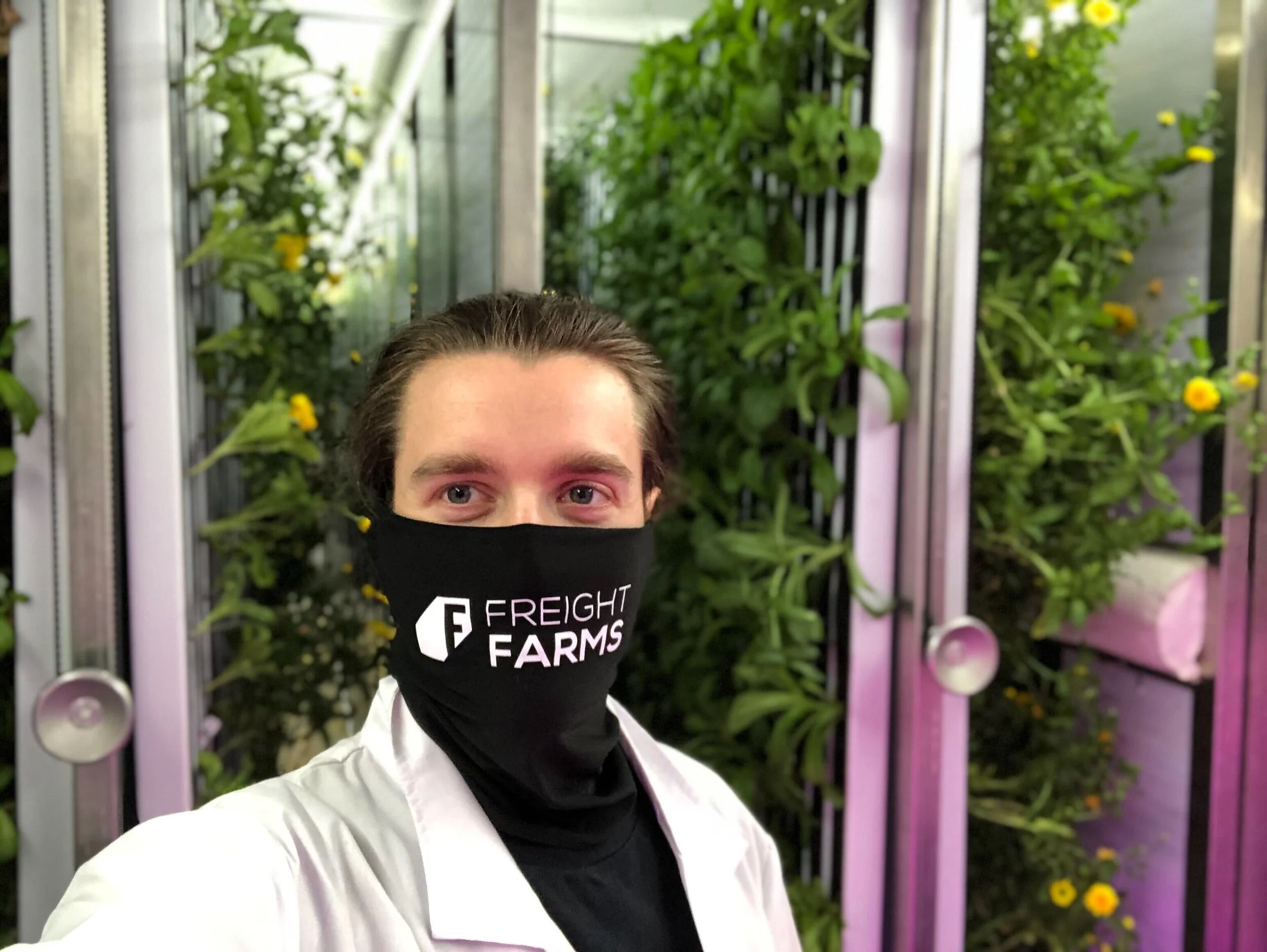The Fresh Food Aisle is Getting Fresher
The people want local.
Let’s give it to them!
Have you noticed changes in the grocery aisle of your supermarket? Organic is being joined by terms like locally-grown, hydroponic, CNG (certified naturally grown) on signage, packaging, and labels in the fresh produce aisle. All in the name of letting shoppers know that their food is getting fresher.
Why the change?
Consumer priorities are shifting, and grocers around the world are changing their product offering to meet the demand. Since the priorities include local, sustainable, transparently-sourced food, this means fundamentally changing how big supermarkets do business. Instead of sourcing through traditional channels, produce buyers are diversifying where they get their produce. This could mean finding small local farmers in the area, or–and more increasingly–taking over the supply chain by growing on-site right at the store.
First things first, what’s wrong with the existing system?
The nutrition is lacking.
It leaves something to be desired, and people are starting to pick up on it. First off, unless you’re living and shopping in California or Arizona, most American’s are getting their fresh food delivered to them several days, if not weeks, after peak freshness. As a result, the fruits and vegetables you’re eating for vital vitamins, minerals, and other nutrients aren’t really cutting it. Spinach, for example, loses 47 percent of its folate concentration after eight days and 75 percent of its vitamin C in seven days–and that’s if it’s properly refrigerated!
It’s not always safe.
83 percent of consumers are concerned about food contamination from bacteria or germs. This issue came to a head in 2018, when the U.S. market experienced three E. coli outbreaks in romaine lettuce crops alone. While food contamination is a potential risk of any food operation, the way our food system is set up makes it easier for disease to spread and more difficult to find the origin of the disease.
The first part of the issue is centralized production, which makes it difficult to contain outbreaks that start with a contaminated water source. From there, produce is amassed and transported across the country, coming in contact with many (potentially unwashed) hands. By the time it reaches the grocery shelves, it’s nearly impossible to trace the food’s exact origin to find the ground zero of the outbreak.
It’s covered in stuff you don’t want to be eating.
Consumers value transparency around pesticide and fertilizer use 31 percent more in 2017 than in the previous two years. The FDA has reported that 54 percent of fruit and 36 percent of vegetables arrive on our plates with traces of pesticides still on them. And it’s not just one chemical: USDA tests found residues from 52 different pesticides on lettuce. This chemical cocktail included three known or probable carcinogens, 17 suspected hormone disruptors, 10 neurotoxins, 8 developmental or reproductive toxins, and 14 honeybee toxins. (We covered all this and more in this blog).
Just the stats
83% of shoppers are afraid of food contamination from bacteria or germs
31% more shoppers value transparency around pesticide and fertilizer use in 2017 than did in 2015.
Shoppers want local food
The local food market, once a fringe part of the produce industry reserved for farmstands and farmers markets is becoming one of the fastest growing segments: from 2008 to 2014, it more than doubled from $5B to $12B, and is projected to hit $20B before the end of the year.
For many shoppers, eating local is a way to ensure their food is fresh, nutritious, food-safe, and pesticide-free. A 2017 IRI report found that 30 percent of shoppers choose their grocery store based on local produce offerings. The report also found that 47 percent of shoppers felt that by offering locally sourced produce, the store cares more about the overall welfare of them and their family; 54 percent felt that the store cares about the local community; 40 percent felt like the store lived up to their values and expectations, and 38 percent felt that the store understood their values and preferences. And the trend is growing stronger, millennial shoppers are 67 percent more likely to seek out locally sourced foods.
What’s considered local?
It’s very much in the eye of the beholder! For 39 percent of U.S. shoppers, that means considering the specific distance from where the produce is grown, while 28 percent consider anything grown in state to be local.
Why is organic is no longer enough?
Organic is a regulated term, meaning you need to prove that you are following specific guidelines, such as conserving biodiversity, and using only approved substances. However, as consumers increasingly look to buy organic, the once community-centered practice has become less environmentally sustainable. Today, Big Organic uses huge centralized operations to supply growing demands. Fresh produce ends up traveling thousands of miles, which not only affects the food’s quality and nutritional values, but also contributes to greenhouse gases (thus undermining the idea of eco-friendly farming), and opens organic food up to the same food borne illnesses found elsewhere in the supply chain.
Just the stats
The local food segment is projected to reach $20B by the end of 2019.
30% of shoppers choose their food retailer based on local produce offerings.
67% of millennial shoppers seek out locally sourced foods.
What’s a store to do?
Addressing the demand for local food isn’t just a matter of being on trend–it’s a matter of winning and sustaining business from shoppers who frequent up to six different stores (not including farmers markets). Most stores have a long way to go: 55 percent of surveyed conventional store shoppers reported barriers to buying local products because of limited offerings.
Then there’s the gap between expectation and reality: 81 percent of grocers believe they are delivering on the promise of fresh, while 67 percent of consumers are completely dissatisfied with local fresh produce in their grocery store. Those dissatisfied customers are unlikely to stick around if the store isn’t providing their number one demanded products.
Just the stats
55% of shoppers say they have limited local offerings.
81% of stores say they deliver on the promise of fresh.
67% of shoppers are unhappy with their stores’s local fresh produce.
The catch
Again, locally-sourced produce is a no-brainer if you’re living in sunny California where year-round warm temperatures that can sustain farming through all seasons. The rest of us experiencing four seasons in Boston, or Denver, or Nova Scotia… we can forget about year-round local food at the store. It’s impossible to cultivate delicate summer greens outdoors in the snow and frozen ground, and grocers know it. Plus, even in the short growing months, many sourcing managers are skeptical about backing small local farms–what happens if there’s a blight, a sudden freeze, and half the promised basil doesn’t make it to the store.
“No,” most grocers say, “it’s safer to stick with what we know”...even if that means the possibility of E.coli or the 2-day shelf-life by the time it schleps from Arizona to Toronto.
Let’s try indoor farming
As grocery stores of every size attempt to win over customers with their local food offerings, the use of hydroponic indoor farming seems to be the best way to ensure quality, quantity, consistent production, and year-round availability. In just the scope of Freight Farms technology, hydroponic indoor farming has seen huge success in grocery stores around the world.
Our hydroponic container farm, the Greenery (and its predecessor, the Leafy Green Machine) creates opportunities to grow food in new and exciting places.
It eliminates dependence on farmable land.
By growing indoors, parking lots, unused industrial spaces, rooftops…suddenly all of these locations become perfect locations for vertical hydroponic farms.
This makes on-site production a very realistic possibility, while also setting the Greenery apart from other indoor methods (warehouses, greenhouses) that require more space and special construction that make them difficult and costly options for crammed urban areas or fully developed shopping plazas.
It’s on-site and interactive.
The Greenery can be dropped anywhere and ready to go in just a few days time. The result is a system that customers can see and interact with–they might even be able to meet the farmer who grew and delivered their cilantro across the parking lot (or follow along on Instagram). That’s about as ‘local’ as it gets.
It’s season-agnostic.
The Greenery also gives growers independence from their home climate. Our fully-controlled systems create ideal growing conditions year-round, making it possible to grow food in inhospitable environments. Finally, by leveraging vertical growing techniques, our farms take advantage of a third growing plane, meaning they can output several times more than the comparable amount of traditional land.
Here’s how it works IRL…
Option 1: Do it yourself.
ICA Maxi Supermarkets in Sweden
ICA Maxi Högskolan, one of 84 locations of the popular ICA Maxi supermarket chain in Sweden, decided to take control of their own supply. In the spring of 2019, the Swedish grocer put a Leafy Green Machine directly at the site of their bustling store to create the most local, fresh, and transparent food source possible. Just over a year later, another ICA store, ICA Åre, added a Leafy Green Machine on-site of their storefront at the bottom of one of Sweden’s most popular ski resorts. The farms tie into ICA’s overall dedication to creating a ‘customer-first’ experience and is just the latest effort to combine this mission with modern and innovative technology. Learn more about the ICA Maxi farm.
Update: ICA Maxi just purchased their third container farm—the supermarket chains’ first Greenery! The farm will be located at an ICA store closeby Örebro University in Örebro, Sweden.
“Freight Farms’ technology is especially helpful in Sweden, where our short growing seasons can limit crop availability throughout the year and increase our reliance on imported produce. We’re now able to shorten the distance food travels to get to our customers from 2,000 kilometers to just 30 meters.”
North Market in Minneapolis, Minnesota
North Market is a grocery store in North Minneapolis that offers nutritious food at affordable prices in an area that has historically experienced food apartheid. The market is just one social enterprise under the umbrella of the nonprofit, Pillsbury United Communities. In the summer of 2020, PUC moved their Leafy Green Machine model Freight Farm to just 50 feet away from the entrance to North Market. The farm is able to grow 11 vegetables and herbs for the grocery store including three varieties of romaine lettuces, green oakleaf, basil, Thai basil, rosemary, thyme, lemon balm, sage, and mint. In addition to making hyper-fresh and nutritious produce accessible to the community, the North Market is also reducing food miles and food waste and experiences cost-savings that they pass on to the end customer.
Read what Supermarket Perimeter has to say about the role urban farming is playing in local food production at North Market here.
Option 2: Partner with a local farmer.
Freight Farmers Around the World
A third, and equally rewarding option is to source from a local purveyors that are farming with the same modular hydroponic technology. This gives big brands the ability to invest in a local business and give their customers the feeling of knowing who their farmer is (“He lives just down the street!”). If the partnership is especially productive, the Greenery’s design makes it easy to move. The farmer could simply re-locate to the store’s location and everyone would benefit: the farmer would have an easy deliver ‘route’, the store could promote their hyperlocal offering, and customer could buy the produce confident that it was local, fresh, nutritious, sustainable, food-safe, and chemical-free.
















